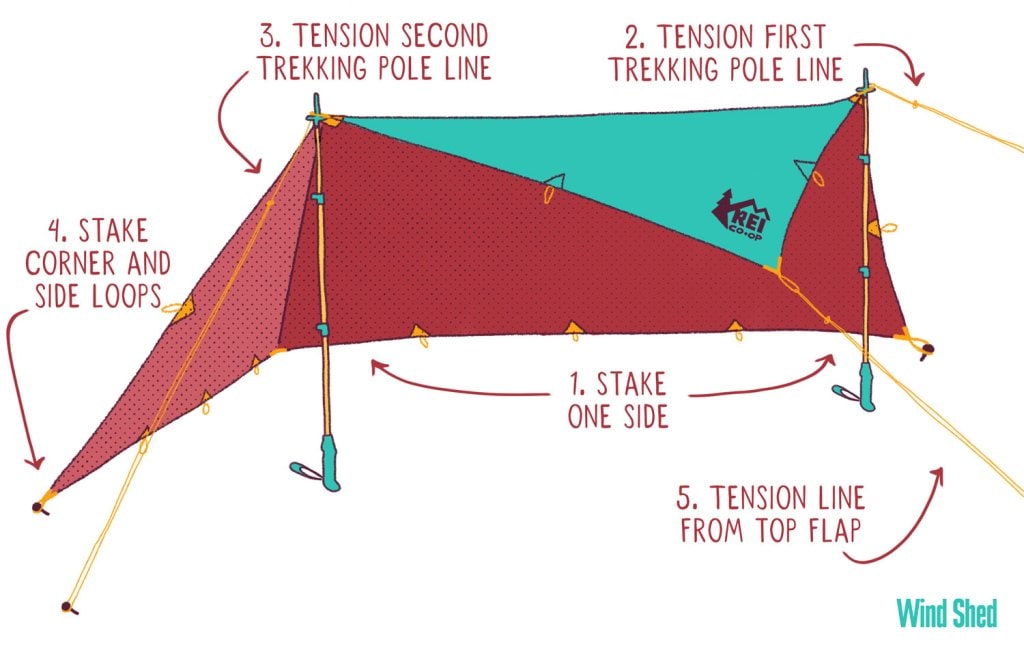
Classic A-Frame tarp configuration You can also set it up using a diamond method which is detailed below this one. Its usually best to set the tarp up in the lean-to style.

A tarp for hammocks can be secured in an A-shape aka an A-frame over the top of your hammock.
Best way to set up a tarp. What you need to set a Tarp. You will need to have a tarp and some rope in order to make your tarp. Some people may also want to bring wire as well in case they are setting up their camp near a body of water or the shoreline.
You can use any kind of clothesline that you prefer or even string if you dont want it visible at all times. Its usually best to set the tarp up in the lean-to style. This consists of having two ends placed up high and the other two placed low to the ground toward the prevailing wind.
When learning to set up a tarp for camping you must consider using an anchor. Just as anchors are characteristically used to hold various objects in place an anchor would also be needed to hold your tarp in position. There are mighty winds that would threaten to blow off the tarp but a good anchor would prevent that from happening.
Quick Trick Episode 11 How to setup a tarp without using knots. This simple and easy tip lets you attach your tarp to a ridgeline without tying a single. Spread your tarp over the ridgeline so that it is roughly centered.
You can run the rope through the middle grommets to make it stay centered but this usually makes setup more difficult and its harder to adjust the tarp later. Repeat throwing the firewood tied to the loose end of the rope up into the second tree and tie it off. Set up as if the weather is actually bad now pitch as if the wind is strong with extra securing measures this way if the wind does pick up in the night you wont have to scrabble about in the dark when you are half asleep trying to prevent your tarp from turning into a parachute.
Set up four different shelter styles with a canvas tarp. A-Frame Compact A-Frame Lean-to and Barrier. These shelters will have you camping in style in any.
Find two trees and setup up the tarp with guylines and staked corners either with proper tent pegs or wooden stakes for good wind and rain protection. Not suitable for rainy andor windy weather conditions. Use two alpenstocks or wooden stakes 39-49ft 12-15m instead of trees.
The purpose of a ground sheet is to create a barrier between you and a damp ground and also help protect your tent floor from sticks and stones and punctures. Ive tried vast tarps and titchy tarps and reckon1 for a solotandem little tarp go for nothing less than 3m long and 2m wide. Big tarp for groups the bigger the better up to about 5m max and the same wide.
To me the perfect sizes are. Little tarp 3m x 24m big tarp 45m x 3m. Building a Simple Shelter with a Tarp.
There are a few different ways to set-up a tarp. Wind direction the location of trees or other supports and what it will be used for all influence the choice of shape. You can build a basic shelter using two straight tent poles rope pegs and of course a tarp.
If its windy peg down one side of the tarp to stop it from folding over on itself until it is set up. 3 Layout your equipment. The key to an easy and stress free tarpaulin set up is setting out all your pieces and to follow a sequence that will off set the balance of the tarpaulin structure against itself as you set-up.
Pitch on the high side of any natural ground ridges so that any water run. There are two great ways to set up a tarp. A tarp for hammocks can be secured in an A-shape aka an A-frame over the top of your hammock.
Classic A-Frame tarp configuration You can also set it up using a diamond method which is detailed below this one. Tarp set ups for couples or groups. When it comes to setting up your tarp for couples you can opt for the set ups shown above except those specifically designed as hammock covers and simply replicate them with a larger tarp.
With groups it is best to either hang your hammocks close together or to opt for a multi-person hammock. This openness also means you wont have as much protection from the elements. The tipi design is easy to set up requiring just a ridgeline that attaches to one tie-out point on the tarp and a few stakes to secure the sides and back.
The classic A-frame is one of the quickest and easiest ways to configure a tarp. It uses a ridgeline to support the center of the tarp and stakes on the side to create the triangular shape of a letter A. Krik of Black Owl Outdoors explains the nuances of setting up a tarp with a ridgelineENO Pro Fly - httpamznto1QyZUuZBECOME A PATRON—–.